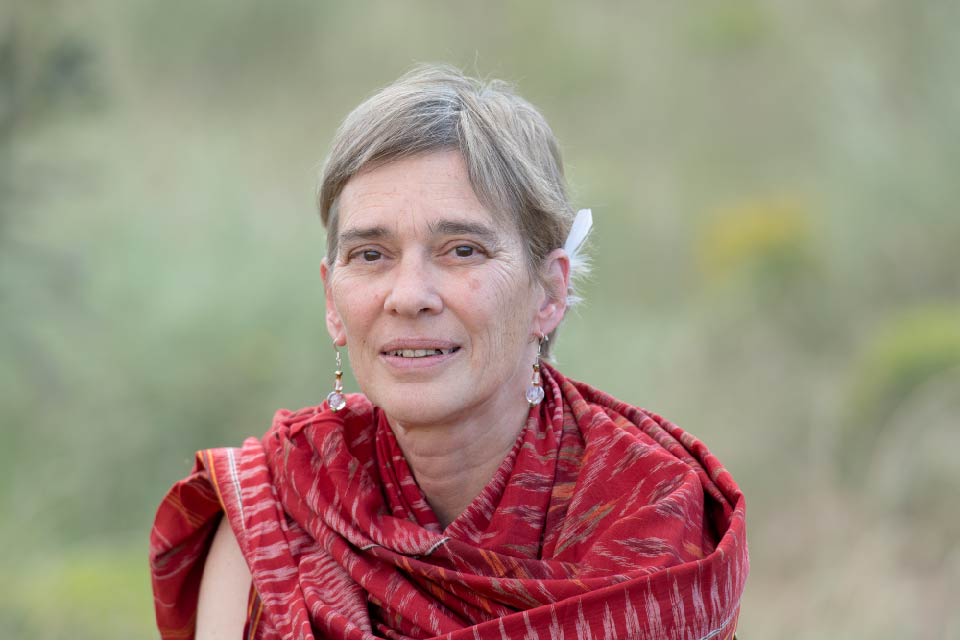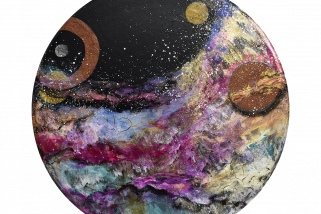
“… and Stones” by Gillian Barlow
She bends over to pick up a pebble – no, not that one – her hand skips across the roundish brown pebble to the black oval one and then on beyond to where she sees below the surface, the very one she wants – the chosen one. She curls her fingers around it, lifts it from the river floor and turns it over, feels its smoothness, its coolness, its rounded edges, the way the colours move subtly from a brownish beige to yellow. Her hand closes around it, then opens. The final one. She peers at it, at its colours as they mingle, sometimes as a gradation, sometimes as an abrupt change. How do the colours do that? She rubs her finger over the change, closes her eyes to see if she can feel this, rubs her finger across it again and again to try to rub it out. Opening her eyes and looking more carefully, she notices a darkish line that separates the two colours. The last one. She plunges her hand into her pocket, holding the pebble tightly and then lets it go. A crashing of ages. The end of the line. She hears it clack there amongst the others. She feels each stone, caresses them, checks their weight.
She runs through what she has in her pockets, The pebbles and stones that will accompany her are:
Grey sharpish ones that cut and bruise the fingers and keep you on the path.
Safe, multi-coloured ones to remind you, life can, or was or might, be good sometimes.
Long, smooth, sexual ones to remind of a person’s body.
Tiny fragments to remind you that this is not everything, not the whole of it.
A handful of small ones.
Five large ones.
Four like balls.
Eight with harsh stripes through them; the truth cut into their very depths.
One like a woman’s leg.
One that is perfect for skimming across the water.
One shaped like a heart to remind you of your loves.
Three darkish, reddish, orangey coloured ones.
Two like blades – one side perfect for holding, the other for cutting.
Collecting stones as she had collected people. Casting them off if and when they are no longer useful. Overlooking so many. She reddens. So many. How many exactly? Her privilege blinding her to so, so many. She hesitates, panics some… Can she make up for it now by collecting stones and hence people she had by-passed earlier?
She tries to turn back but then places her hand once more into her pocket, feels the heart shaped stone on top, takes strength from it – so corny, hopes they will notice and recognize the sign. She feels the indentation in the top of the heart-shaped stone.
She walks into the current thoughtfully, feeling the stones, convincing herself she is doing it for her, for him, for the others, knowing it is for herself, knowing she can’t go back now. She has ridden that wave one too many times.
She feels another wave arriving – waves made by fish beneath, by boats on top, by her walking, her stomach reacting to what she is doing. The waves’ lapping is soothing. Reckless. Free-ing. The thick river water enticing her. She wades deeper. Her clothes beginning to clutch and catch around her legs, dragging in water and river mud. Water at her waist. Water at her neck. At her chin. Her mouth. Her nose. She closes her eyes. The water continues flowing around her.
She breathes out. One hand she keeps in her pocket feeling the stones, grounding her, earthing her in water. The other hand tries to brush the water aside, trying to make a path before her, blindly feeling her way.
Don’t panic. Not now.
She needs to take a breath. There is no air – only water. Relax. She grabs again at the heart stone. Her cardigan’s pockets sagging with the pebbles and water. Tipping. Relax. Sinking. Relax.
Remember this.
The current of life flowing. Her feet planting one in front of the other on the muddy floor of the river. Don’t float off. Be firm. Be solid, stone-like. It is only water. It is only walking.
She moves in against the current.
____________________
Share your response to this work, in any form, here

Gillian Barlow Artist Statement:
Gillian is a writer and architect who works in Australian Aboriginal communities and on accessible
housing. She writes experimentally – in ficto-criticism and zuihitsu. She has twice attended the
AROHO womens’ writing retreat where she has made the most fantastic friendships and had
unforgettable writing conversations. Her book (as yet untitled) is to be published with Saddle Road
Press at the end of 2016. She has had a number of short stories published in anthologies and her
work was featured in the “Off the Margins”.






